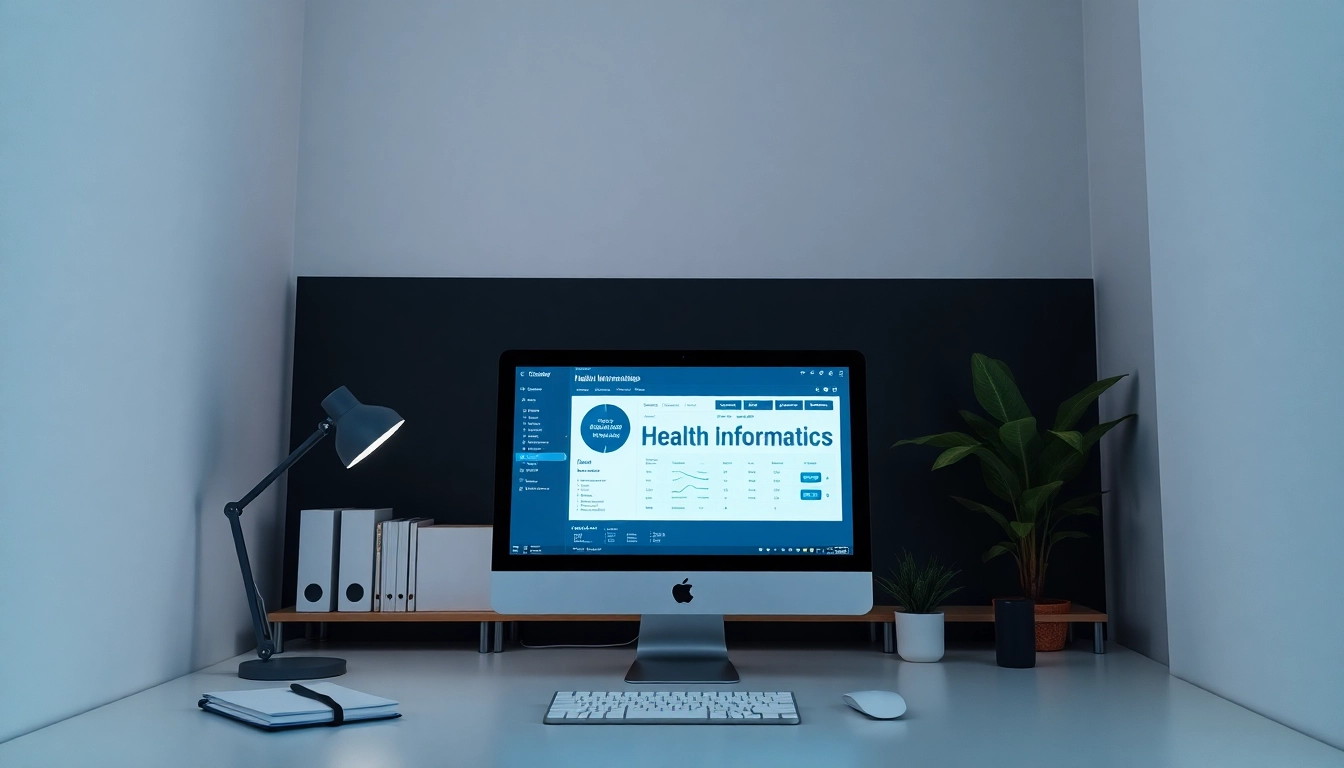Understanding Informatics
Informatics is an interdisciplinary field that merges information science, computer science, and specific domain knowledge to improve the management and delivery of healthcare services. By utilizing technology effectively, informatics plays a crucial role in advancing healthcare systems, enhancing patient care, and enabling healthcare professionals to make well-informed decisions. As healthcare continues to evolve, platforms such as www.informaticsview.com serve as essential resources for professionals seeking knowledge and solutions in this rapidly changing landscape. This article will delve deeply into the various aspects of health informatics, exploring key concepts, core applications, challenges, best practices, and the future of the industry.
What is Informatics?
Informatics can be broadly defined as the study and use of systems for storing, retrieving, and sending information. It involves the application of computational systems to manage and understand data. This is particularly significant in healthcare, where informatics integrates clinical practice with information technology to streamline processes and enhance outcomes. In essence, informatics can be viewed as the bridge that connects data, healthcare professionals, and patients.
The Importance of Informatics in Healthcare
Informatics holds paramount importance in the healthcare sector for several reasons:
- Improved Patient Care: Within informatics, data-driven decision-making leads to better diagnosis, treatment planning, and overall patient care. For example, Clinical Decision Support Systems (CDSS) can flag potential drug interactions, thereby reducing errors.
- Enhanced Efficiency: Informatics streamlines operations through electronic health records (EHRs), allowing for easier data access and coordination among healthcare providers.
- Informed Policy-Making: By analyzing healthcare data, policymakers can craft more effective health policies that respond to real-world trends and challenges.
- Increased Patient Engagement: With tools like online patient portals, patients can access their health information, schedule appointments, and communicate with their healthcare providers, fostering a more engaged patient population.
Key Concepts in Health Informatics
To fully grasp the significance of health informatics, it’s essential to understand its fundamental concepts:
- Data Management: Focuses on collecting, storing, and processing data efficiently and securely.
- Information Systems: Involves using technology-driven systems to manage healthcare information, such as EHRs and telemedicine platforms.
- Clinical Informatics: A subset of health informatics that specifically applies informatics knowledge and methods to optimize healthcare delivery.
- Public Health Informatics: Concentrates on the application of informatics in public health practices, enhancing health surveillance and disease prevention strategies.
Core Applications of Health Informatics
Electronic Health Records and Data Management
Electronic Health Records (EHRs) are one of the most significant advancements in the healthcare sector, transforming how patient information is recorded, stored, and accessed. EHRs provide a comprehensive view of a patient’s medical history, treatments, medications, and test results.
Key benefits of EHRs include:
- Accessibility: Healthcare providers can quickly retrieve patient data, leading to timely decision-making.
- Coordination: EHRs facilitate the sharing of information between different departments and providers, enhancing the continuity of care.
- Reduced Errors: By replacing handwritten notes and traditional paper records, EHRs minimize the risk of miscommunication and errors.
However, the implementation of EHR systems must be approached cautiously. Proper training and change management strategies are vital to ensure that healthcare professionals fully utilize the system’s capabilities.
Clinical Decision Support Systems Explained
Clinical Decision Support Systems (CDSS) are integral to health informatics, providing healthcare professionals with data-driven insights during patient care. These systems analyze clinical data and present recommendations, alerts, and reminders based on the best practices and evidence-based guidelines.
CDSS can significantly enhance care quality by assisting in:
- Diagnosis: Suggesting possible diagnoses based on presenting symptoms.
- Treatment Plans: Offering evidence-based treatment recommendations tailored to the patient’s unique health profile.
- Preventive Care: Identifying patients at high risk for certain conditions and suggesting preventive measures.
As with any technology, the success of CDSS relies on the integration of systems into the clinician’s workflow, ensuring they are user-friendly and effectively used to support – rather than hinder – clinical decision-making.
Telemedicine: A Modern Approach to Patient Care
Telemedicine has exploded in popularity, especially following the global pandemic. It employs technology to provide medical care remotely, overcoming geographical barriers and ensuring patient access to healthcare services.
Key advantages of telemedicine include:
- Accessibility: Patients in remote areas can connect with specialists without the need for travel.
- Convenience: Patients can schedule virtual consultations at times that suit their needs, improving compliance with follow-up care.
- Cost-Effectiveness: Reduces overhead costs associated with in-person visits and can lead to lower healthcare costs for patients.
To maximize the benefits of telemedicine, healthcare institutions must invest in robust technology solutions and ensure patient privacy and data security in their digital interactions.
Challenges in Health Informatics Implementation
Data Privacy and Security Issues
While informatics advances healthcare, it also raises concerns regarding data privacy and security. With the increasing digitization of health information, protecting patient data from breaches and unauthorized access has become a critical issue.
Key strategies for safeguarding data include:
- Encryption: Data encryption ensures that sensitive information is unreadable to unauthorized users.
- Access Controls: Implementing role-based access limits data exposure to only those healthcare professionals who need it to perform their jobs.
- Regular Audits: Conducting routine audits helps identify vulnerabilities and areas for improvement in security protocols.
With strict compliance to regulations like HIPAA in the United States, healthcare organizations must continually improve their security measures to maintain patient trust.
Interoperability in Health Systems
Interoperability, or the ability of different information systems and technologies to work together within and across organizational boundaries, is a significant challenge in health informatics. Disparate systems can lead to fragmented patient care and inefficiencies.
Strategies to enhance interoperability include:
- Standardized Protocols: Adopting standardized data formats allows different systems to understand and communicate with one another.
- Health Information Exchanges (HIEs): Utilizing HIEs facilitates the secure transfer of patient information between systems and organizations.
- Collaborative Policies: Stakeholders should collaborate to promote policies that encourage interoperability within the healthcare ecosystem.
Addressing User Resistance in Technology Adoption
Resistance to change can hinder the successful adoption of health informatics tools. Healthcare professionals may feel apprehensive about using new technology due to concerns over job security, usability, or additional workload.
To address these issues, healthcare organizations should focus on:
- Training and Support: Providing comprehensive training programs helps staff feel confident in using new systems effectively.
- Involvement in Decision-Making: Engaging end-users in the selection and implementation process fosters a sense of ownership and can lead to higher acceptance rates.
- Highlighting Benefits: Demonstrating the positive impacts of informatics on patient care and operational efficiency can help alleviate fears regarding new technologies.
Best Practices for Leveraging Informatics
Integrating Informatics Tools into Daily Operations
To truly benefit from informatics, these tools must be integrated seamlessly into everyday operations. Steps to ensure effective integration include:
- Workflow Analysis: Investigating existing workflows helps identify integration points where informatics tools can provide value.
- Pilot Programs: Implementing pilot programs allows organizations to test informatics tools on a smaller scale before full implementation.
- Feedback Mechanisms: Creating channels for continuous feedback ensures that the integration process adapts to the needs of users.
Training Staff for Effective Use
Successful implementation of health informatics hinges on the capability of staff to utilize these tools effectively. Training initiatives should focus on:
- Comprehensive Training Programs: Offering robust training that covers both the technical aspects and the practical applications of the technology.
- Ongoing Education: Providing continuous learning opportunities to keep staff updated on technological advancements and best practices.
- Cultural Competence: Educating staff on issues related to health equity and cultural sensitivity can improve interactions with diverse patient populations.
Measuring the Impact of Informatics Solutions
To evaluate the effectiveness of informatics tools, organizations should define key performance indicators (KPIs) and utilize quantitative and qualitative metrics. Metrics to consider include:
- Patient Outcomes: Tracking improvements in patient care, such as reduced hospital readmission rates or improved treatment adherence.
- User Satisfaction: Collecting feedback from staff regarding their experiences with informatics tools and their perceived impact on workflow.
- Cost Savings: Analyzing financial data to assess whether informatics initiatives lead to cost reductions in operations or patient care.
The Future of Health Informatics
Emerging Technologies and Trends
The landscape of health informatics is constantly evolving, driven by emerging technologies. Some notable trends include:
- Artificial Intelligence (AI): AI is poised to revolutionize diagnostics, treatment recommendations, and patient engagement, aiding clinicians in making faster and more accurate decisions.
- Big Data Analytics: Leveraging big data allows for deeper insights into patient trends, outcomes, and population health management.
- Wearable Technology: The use of wearable devices that monitor health metrics in real-time can empower patients and provide valuable data to healthcare providers.
Policy Changes Affecting Informatics
As health informatics continues to mature, regulatory frameworks will adapt. Expected policy changes might include:
- Stricter Data Protection Laws: With increasing concerns over data privacy, regulations like GDPR in Europe may set the stage for stricter U.S. data protection measures.
- Incentives for Interoperability: Governments may introduce incentives to promote interoperability standards across EHR systems.
- Telehealth Reimbursement Policies: Ongoing changes in the reimbursement landscape for telemedicine services may affect how readily these services are offered.
Vision for Healthcare Informatics
Looking ahead, the vision for healthcare informatics encompasses a future where technology and data synergistically enhance patient care on every front. A holistic, integrated approach to informatics will focus on:
- Patient-Centric Care: Personalized treatment plans driven by data insights and patient preferences will be at the forefront of healthcare delivery.
- Interconnected Health Systems: Seamless connectivity between healthcare providers, patients, and systems will create a cohesive health ecosystem.
- Continued Innovation: Ongoing research and innovation will drive the development of new tools that further expand the capabilities of health informatics.
In conclusion, health informatics is not just a technological enhancement but a fundamental shift in how patient care is delivered. By understanding its significance, core applications, challenges, and best practices, healthcare professionals can effectively navigate this complex landscape. As we look toward the future of healthcare, embracing the full potential of informatics will be essential to improving health outcomes and providing high-quality, efficient care for all.



